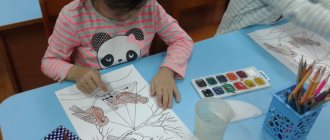On the topic: methodological developments, presentations and notes
The methodological manual promotes the development of mental processes of memory, attention, and perception of the thought processes of preschoolers. Formation of a holistic picture of the world, development of fine motor skills, sensory.
Musical and didactic games occupy a special place in the musical development of a preschooler. The proposed games are aimed at developing the perception of music, the development of vocal singing, and spatial orientation.
Consultation for educators.
1. Reasons for delayed speech development in children. 2. Tasks. 3. Examples of finger games.
Consultation for educators.
CONSULTATION FOR TEACHERS on the innovative activities of a music director on the topic: “The use of art therapeutic methods and technologies in .
One of the important tasks of the comprehensive development of a child is the education of musical culture. Its foundations are laid in childhood. In this regard, a large place is given to music in kindergartens, &nda.
Discussions.
Musical - didactic games and teaching aids on music
Municipal preschool educational autonomous institution
child development center – kindergarten “Scarlet Flower”
Methodological development
A set of musical and didactic games for the older age group.
Prepared by: music director:
Legostaeva T.I.
Pyt-Yakh
Games for developing a sense of harmony
Listening to music
Goal: To develop children’s ability to distinguish musical works.
Game material: 4-5 pictures illustrating the content of musical works familiar to children (these can also be instrumental pieces), player.
How to play: Children sit in a semicircle, pictures are placed on the table in front of them so that they are clearly visible to everyone playing. Play a piece of music. The called child must find the corresponding picture, name the work and the composer who wrote this music. If the answer is correct, everyone claps.
The game is played during music classes and during free time.
What music?
Goal: To improve children’s ability to distinguish the nature of music and identify types of dances.
Game material: Player, recordings of waltz, dance, polka; cards with images of waltz, folk dance and polka dancers.
How to play: Children are given cards. The music director performs musical pieces on the piano (recorded) that correspond to the content of the pictures on the cards. Children recognize the work and pick up the correct card.
Major - minor
Goal: To improve children’s ability to distinguish the nature of music, to consolidate the concepts of “major - minor”.
Game material: Player, recordings of works, yellow cards with a smiling face, black cards with a sad face (corresponding to major and minor).
Progress of the game: The teacher first introduces the children to the terms “major - minor”. The children are given cards. The music director offers to “play, find out the mood”, performs musical pieces on the piano (recorded). Children, depending on the nature of the works, raise conventionally designated cards.
Song - dance - march Goal: To develop an understanding of the main genres of music, the ability to distinguish between a song, dance, and march. Game material: 1st option: Long white cards, divided into three squares. Small cards depict a flute, tambourine, drum (song, dance, march). 2nd option: The squares of a large card depict: a singing girl, a dancing girl, a marching boy with a drum. Progress of the game: Children listen in turn to three plays of different genres. After listening, take a square with a picture (corresponding to the genre) and place it on one of the empty squares of a rectangular card or cover the corresponding picture with a chip. Musical material: “Trumpet” by Tilicheeva or “Two Grouse” by R.N.P., “Under the Green Apple Tree” by R.N.M., “March” of your choice.
steps
Purpose: To teach children to distinguish between the movement of sounds up and down.
Game material: A ladder of five steps, toys (matryoshka, bear, bunny), children's musical instruments (accordion, metallophone, harmonica).
Progress of the game: First, the teacher, and then the child leader, performs a melody on any instrument, the other child determines the movement of the melody up, down, or on one sound and, accordingly, moves the toy (for example, a bunny) along the steps of the ladder up, down, or taps on one step . The next child uses a different toy.
Several children participate in the game.
How many of us are singing?
Goal: To teach children to distinguish the number of sounds in a chord.
Game material: Card with three cells depicting singing children (in the first there is one girl, in the second there are two children, in the third there are three).
Progress of the game: The teacher or child leader plays one, two or three different sounds on one of the instruments. The called child determines the number of sounds and places the corresponding number of nesting dolls on the card in the desired cell. It is imperative to remind children that they should take as many nesting dolls as different sounds they hear.
The game is played with a small subgroup of children in their free time. It is necessary that the teacher first act as a leader.
Who sings? Goal: To develop in children the ability to distinguish registers (high, low, middle). Game material: Three cards made of cardboard with the image of mom, dad, son. Progress of the game: The teacher talks about a musical family, shows pictures and says that everything This family loves music, but they sing in different voices. Dad is short, mom is average, son is thin and tall. The teacher performs three plays and explains that the play, sounding in a low register, is called “The Pope's Story” (about a military campaign); the piece, sounding in the middle register, is called “Lullaby” (mother sings to her son); in a high register - “Little March” (the boy hums and marches). After performing each piece again, the children guess whose music was played, select the desired picture and show it, explaining their choice. Musical material: “Papa's Story”, “Lullaby”, “Little March” by G. Levkodimov.
Trumpet Purpose: To train children in the difference between the sounds of fourths (sol 1 to 2). Game material: 8 lotto type cards with a colored stripe at the bottom (2 with red, 2 with blue, 2 with green, 2 with yellow). Each card has 5 cells, 3 of them have an image of a pipe tilted down or raised up. All cards have two empty cells; they are interspersed differently with those with a picture. A pipe down means a low sound, and up means a high sound. Cards with colored images of pipes. Progress of the game: The presenter gives the children two long cards with stripes of the same color. Small cards are stacked one on top of the other with the pictures facing down. The teacher sits behind the screen with small cards and a metallophone. Invites the children to sing the song “Trumpet” and says that the sound “sol” is a lowered trumpet, and the sound “do” of the 2nd octave is a raised trumpet. The presenter takes the top card with the picture facing him and plays a sound corresponding to the image of the pipe. The child who has such a pipe on his map answers. If he answers correctly, he receives a card and covers the picture on his card with it.
Games to develop a sense of rhythm
Walk
Goal: To teach children to mark long and short sounds.
Game material: Musical hammers according to the number of players; magnetic board and cards with images of large and small objects (suns, mushrooms, berries), indicating short and long sounds.
Progress of the game: The content of the game corresponds to a similar game played in the younger group, but, in addition, children must convey a rhythmic pattern - lay out cards on a magnetic board. For example: “Tanya took the ball,” the teacher says. The child slowly knocks a musical hammer on his palm and lays out images with large objects. “It began to rain frequently, heavily,” continues the music director. The child quickly knocks with a hammer and lays out cards with images of small objects.
The game is played during class and during free time.
Learn to dance
Goal: To train children in conveying different rhythmic patterns.
Game material: Large matryoshka and small ones (according to the number of players).
Progress of the game: The game is played with a subgroup of children. Everyone is sitting around the table. The teacher has a large nesting doll, the children have small ones. “The big matryoshka teaches the little ones to dance,” says the music director and taps a simple rhythmic pattern on the table with his matryoshka. All children simultaneously repeat this rhythm with their nesting dolls.
When repeating the game, the child who has completed the task correctly can become the leader.
Cockerel, hen and chick Purpose: to train children in the perception of three rhythmic patterns. Game material: 8 long lotto-type cards with a colored stripe at the bottom and a non-colored outline image of a cockerel, hen and chicken; 32 colorful little cards showing a rooster, a hen and a chick. Metallophone, screen. Progress of the game: The leader of the game is a teacher - musician. He invites children to learn to play the game “Rooster, Hen and Chick.” He invites 4 children and places 2 cards on the table for each player. He places a stack of small cards and a metallophone behind the screen. Everyone sings the opening song. The teacher takes the small top card in the stack with the picture facing him. Taps the corresponding rhythmic pattern. Explains to the children that they need to listen and then look at the presenter’s colored cards, and then carefully at the picture of grains. If it coincides with the rhythmic task, then you need to answer the question of the game leader. Then the teacher shows how to place the card on the corresponding cell of your card. The teacher picks up another card, plays a rhythmic pattern and asks: “Who pecks the grains?” The child whose cards have the same color as the small card raised by the teacher answers. If the child answered correctly, he receives a card. If the answer was incorrect, the teacher places the card at the bottom of the foot. He asks the child one time at a time and suggests finishing the game in a group.
Musical material: “The Cockerel, the Hen and the Chick” by N. Murycheva.
Legs and palms
Goal: To train children to reproduce rhythmic chains of short and long sounds. Metallophone, musical sticks, spoons, hammers, drum.
Game material: Cards with rhythmic chains.
Progress of the game: Children play rhythmic chains on various musical instruments using cards. The game is played during class and during free time.
Rhythmic Lotto-1
Purpose: To train children in the distinction and perception of the rhythmic patterns of E. Tilicheeva’s songs “We are going with flags”, “The sky is blue”, “The month of May”, “Brave pilot” (the song is the beginning of “RiKamerton” by E.P. Kostina)
6. Cockerel, hen, chicken - a board musical and didactic game for children of the senior group of preschool educational institutions (according to the Tuning Fork program). Nizhny Novgorod, 2015. (according to the “Tuning Fork” program by E.P. Kostina)
7. Rhythmic Lotto - a board musical and didactic game for children of senior preschool age (according to the Tuning Fork program). Nizhny Novgorod, 2015. (according to the “Tuning Fork” program by E.P. Kostina)



